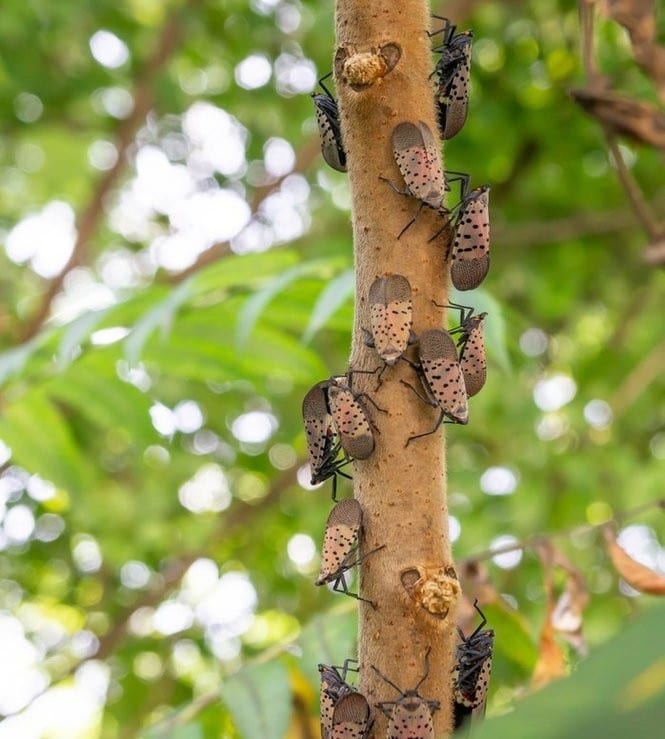It’s been a crazy year so far, and there are plenty of different subjects flooding the news. With all the high-profile, pressing stories, it can be easy for other subjects to be lost in the shuffle, and that can lead to some devastating effects.
While worrying about an invasive pest species may not be at the front of your newsfeed, the spotted lanternfly should still be the main concern, especially for those residing in Pennsylvania. These planthopper insects may not seem like much of a threat on the outside, but these destructive insects could cost the state over $324 million dollars and over 2,800 jobs. Here’s why you should be keeping your eye out for the spotted lanternfly.
The Threat of The Spotted Lanternfly
The spotted lanternfly was discovered in Berks Country, Pennsylvania in 2014 and has since spread across the state. These spotted insects may not seem like much of a threat at first. They are not dangerous to humans or animals, but they do some damage to plants and other fauna that are vital to our way of life.
From destroying fruit trees to completely wiping out plan nurseries, these seemingly inconspicuous flying insects are costing the state millions while additionally putting a dent in the agricultural economy. If they can spread further, the damage they cause can have devastating long-term effects on our way of life.
What is the Spotted Lanternfly?
The spotted lanternfly is a winged insect native to Asia. Appearing in Pennsylvania around 2014, the adult insect is about one inch long and a half-inch wide. They are easily identified by their vibrantly colored wings. The spotted lanternfly has a grey forewing with black spots and hides wings with contrasting red and black patches with a white band. Finally, their abdomens are yellow with black bands. Immature spotted lanternflies are black with white spots and they develop red patches as they grow.
These invasive insects feed on many different fruits, plants, and trees. When they have infested a tree, they form large egg masses. Unfortunately, these pests are hitchhikers. They can easily move throughout the Commonwealth on vehicles, clothes, or other surfaces. Spotted lanternflies can be spread far and wide, and that’s how they can become a massive problem.
Why are Spotted Lanternflies a Problem?
While these colorful insects may not seem like much of a threat, they can cause a lot of damage. They may not be harmful to humans and animals, but they can be deadly for fruit trees, ornamental plants, and so much more. Spotted lanternflies will infest trees, their favorite being the tree-of-heaven.
The infestation will cause the host trees to ooze sap; the leaves will curl, the tree will wilt, and eventually die. As the insects feed on the tree, they secrete a sugary substance that encourages black, sooty mold. While not harmful to us, it will kill plants. And these insects don’t just seek out trees to host them.
The spotted lanternfly will roost anywhere it can find food, which has taken a toll on vineyards, orchards, and other industries. Hops and hardwood, along with fruit trees like apples and cherries, have taken severe hits. This invasive species feeds on over 70 different types of plant species. Their presence can not only cause economic crises and shortages, but they can possibly wipe out theses plant species completely.
What Can You do to Stop the Spread of Spotted Lanternflies?
Fortunately, there are several things you can do to stop the spread of spotted lanternflies. First, it’s important to keep an eye out for the signs and symptoms to spot any infected trees or plants in your area. Infected plant life will ooze or weep and will have a fermented odor. You can often spot sticky fluid, called ‘honeydew,’ on plants or on the ground beneath infested fauna. Additionally, infested plants will have sooty mold; if you spy any of these symptoms, you must alert pest control experts immediately.
In some cases, finding evidence of spotted lanternflies may take a little more effort on your part. Remember, these are hitchhiking insects, so you may very well be carrying them without even knowing it.
As you prepare for seasonal changes, check your outdoor equipment and decorations for spotted lanternfly egg masses. You should check everything, even items you bring indoors.
Should you spot any egg masses, scrape them off, place them into plastic zipper bags filled with hand sanitizer, and close it before disposing of the bag. Check your clothing when traveling and if you park near a tree line, be aware of your surroundings. Spotted lanternflies can easily hitch a ride on your car or your shirt if you get close enough.
When inspecting trees and plants, try to do so at dusk and night when the invasive pests gather in large groups. You can spot them on tree trunks or on plant stems. Finally, always keep a look-out for large egg masses on any surfaces. Brick, stone, trees, or even metal can be a viable surface for these creatures. If you do spot any signs of a spotted lanternfly invasion, be sure to report it to the proper authorities.
 Concluding Thoughts
Concluding Thoughts
Though it may not be the top story in the news, the spotted lanternfly crisis is still very crucial to Pennsylvania agriculture and the economy. If this invasive species is allowed to spread, unchecked, it could result in over $324 million dollars in damages yearly.
Do your part in stopping the spread and stay alert. If you discover a spotted lanternfly infestation, contact a pest control expert today.
[wpforms id=”1017″ title=”true” description=”true”]

